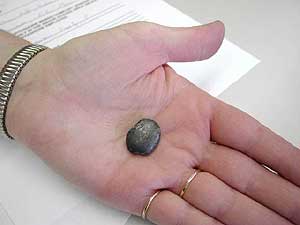|
Photos
More from MPR
Your Voice
|
Who gets the nuggets?
March 19, 2004
A pilot plant in Silver Bay is showing remarkable success producing a new, high content iron pellet for the steel industry. Now, a steel company is ready to build the world's first full-sized iron nugget production plant. But the first plant is more likely to go on-line in Indiana rather than Minnesota. Company officials blame Minnesota's lengthy environmental review process.
Eveleth, Minn. — Doug Johnson says he's frustrated. Johnson is a retired State Senator from Northeast Minnesota, and chief author of legislation that made the Mesabi Nugget pilot plant possible. Mesabi Nugget was built in Silver Bay with a big financial assist from Minnesota - a loan package worth $16 million. Johnson recalls strings attached to that agreement, when it was approved by the Iron Range Resources and Rehabilitation Board.
"The representation was that the plant would be built in Minnesota," Johnson recalls. "That's how it was represented to our board."
But that's not how it's working out. Steel Dynamics Corporation is a part owner of Mesabi Nugget. Steel Dynamics is laying plans for a 500 thousand ton per year steel nugget plant near its steel mini-mill in Butler, Indiana.
Larry Lehtinen is Mesabi Nugget's project manager in Silver Bay. He says the terms in the state's loan package gives Minnesota substantial financial advantages for future nugget plants in the state. But, Lehtinen says, it never gave Minnesota exclusive rights to the nugget process.
 | |||
"So nobody should be under any mis-representation or understanding that this is a Minnesota technology," Lehtinen says. "This is a global technology. It's intended from the get-go - from the very outset - to be proliferated on a global scale."
All things being equal, he says, Minnesota has the cost advantage for nugget plants. But, all things aren't equal. Minnesota has much more stringent environmental review requirements than Indiana, for the permits necessary to build a plant.
Mark Millett is a Vice President with Steel Dynamics Inc. Millett says it will take about six months to get air quality and other permits in Indiana. But permits for a plant in Silver Bay, Minnesota, would take about three years. Millett says he can't wait that long. Prices have skyrocketed for the scrap steel and iron that feeds his mini-mill.
"Well, currently, our needs are being met by going out into the market and buying pig iron and scrap at exorbitant prices," Millett says. "We need iron units now. The opportunity exists today."
Millett sees little logic in the difference between the states.
"Just because Indiana will only take six months to receive a permit versus two to three years, there's absolutely no compromise in any environmental consideration," Millett says. "The best available control technology would be used in Indiana, as it would in Minnesota."
|
We need iron units now. The opportunity exists today.
- Mark Millett, Vice President, Steel Dynamics Inc. |
State lawmakers could accelerate the process. A year ago, lawmakers set aside rules to make a large Iron Range electric power plant more likely. But that would be a bad idea, according to Ann Foss, a Program Administrator with the Minnesota Pollution Control Agency. Foss says an expedited process could create a public uproar.
"People very much want to have things go through the process," Foss says. "They value the process, and all the analysis that goes on during that, and any perception that that's being cut short will automatically make them nervous."
Foss says the process could be quicker if not in Silver Bay. Silver Bay borders Lake Superior on one side and the Superior National Forest on the other. And, Foss says, Silver Bay has a history. The former Reserve Mining company there lost a landmark court fight over its dumping taconite wastes into Lake Superior.
Permit applications are expected in the coming months for plants in both Indiana and Minnesota. Steel Dynamic's Mark Millett says there's plenty of demand for both nugget plants.
"We consume 4.5 million tons of iron units a year," Millett says. "That's a large appetite to satisfy. So, yeah, we have more than an ability to consumer two or three plants for that matter."
The Minnesota plant, while coming on line several years later than Indiana, is also expected to be three times the size of the Indiana operation. If approved, it would produce 1.5 million tons of nuggets each year.
|
News Headlines
|
Related Subjects
|

